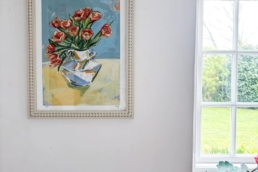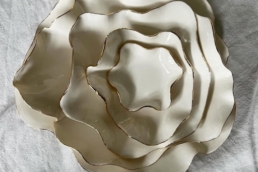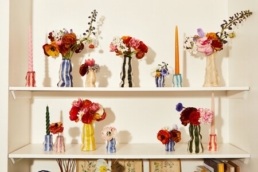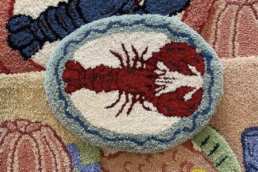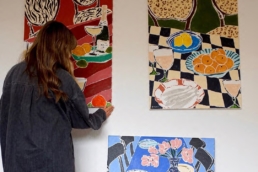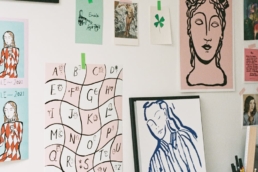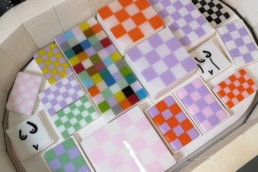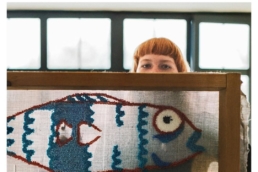Lizzie Scarlett’s ceramics sit somewhere between functional homewares and curious keepsakes. Based in South London, Lizzie brings her background in illustration and textiles to every hand-built piece, combining humour, sentiment, and skill. Drawing on a long-standing fascination with ancient ruins and the stories they preserve, her work explores the passing down of knowledge, the joy of handmade processes, and the everyday beauty of objects that hold memory. With a practice shaped by years of experimentation, from patchwork quilting to her MFA in Crafts, Lizzie continues to build a collection of tactile pieces that feel both deeply personal and joyfully accessible.

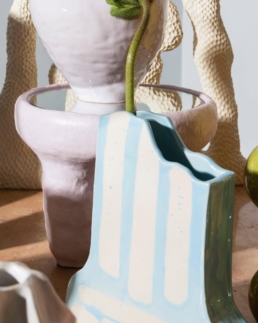
1. Can you tell us a bit about yourself and your artistic journey?
I started in illustration but soon found that a lot of the materials I was using to illustrate were textiles, which led to my Masters in textiles and crafts. I would say my primary practice is patchwork quilting, but for the last 15-plus years, I have also been playing with clay, making functional homeware, exploring the passing of knowledge, skills, and stories through making, interaction, and play, in my little South London studio.
2. What inspired you to pursue your craft? Was there a defining moment or influence that sparked your passion?
I learned lots of crafts from my Grandmother, embroidery, knitting, painting, baking, gardening, etc. I have always loved making with my hands, and through experimenting with ceramics during uni, I realised I could manipulate the clay in the same way as I would a textile pattern, making 2D into 3D.

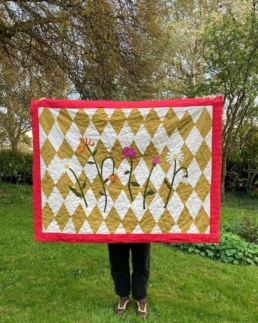
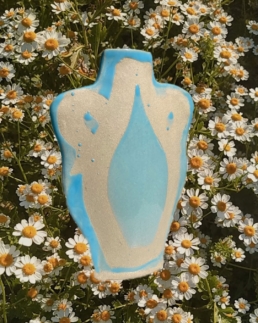
Your craft
3. What materials or techniques do you use, and why are they important to your process?
I mainly work with stoneware clay and hand-build each individual piece. Slab building allows each piece to be one of a kind, showing the marks I make with my fingers and hands.
4. Can you tell us about a favourite piece you’ve created and the story behind it?
My classic vase, I call ‘Vase Vase’, as I draw the line of the vase shape onto the vase to bring out its silhouette. This is a shape I have been making for over 10 years and came from my interest in ancient Greek artifacts, the amphora vase.
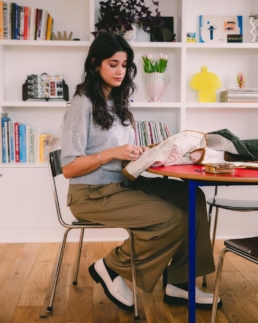
Creative process
5. What does a typical day in your studio or workshop look like?
Like most crafts it’s a very slow process, I start by prepping the clay, rolling it out, and letting it stiffen up a little, then I will choose one of my template patterns to cut all the pieces out before constructing. I will have a few different designs on the go at the same time, all at different stages, so whilst one is drying, I can build another, or work on glazing. You can never have too many hands in a ceramic studio.
6. Do you have any unique rituals or habits that help you stay creative?
Not so unique but a good old fashioned sketchbook is always in my bag, I maybe do not sketch in them as much as I would like to, but full of notes and lists that consists of ideas, diagrams and to do’s.
7. How do you handle creative blocks? Do you have any strategies or tips for overcoming them?
When I’m coming up with new designs, I like to work in silence, sketching and making notes, I find with no distractions the hours pass by so quickly – plus snacks and coffee!
Also just playing, not having any idea what the outcome might be, but testing, practicing, seeing what works, and you never know what is going to come out of a ball of clay.
Challenges and successes
8. What’s the biggest challenge you’ve faced as a maker, and how did you overcome it?
Time – This is ongoing but i’m trying to manage it by giving myself deadlines and planning in my calendar day by day what I need to tick off.
Underselling your craft – Again this is something ongoing, trying to make sure I sell my work at its true value, taking into consideration all of the hours that has gone into making it and all materials and bills.
Cost of your craft – I think for most creatives its always challenging financially, being able to cover your cost of studio rent, materials, etc… This is something I think we always have to keep a close eye on, but its just about trying to keep ontop of it all and believing in myself.
9. What’s been your proudest moment or achievement so far?
It’s always special working on commissions or projects and seeing the final pieces in homes, stores, shoots and magazines, once everything has come together.
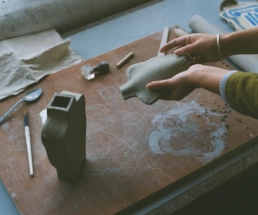
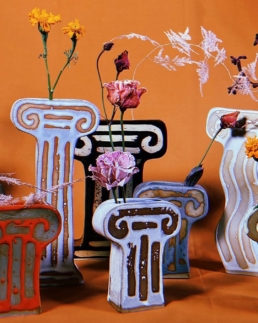
Inspiration
10. Where do you draw inspiration from for your work? What sparks your imagination and creativity?
I love traveling and visiting different museums and galleries, but mostly I love seeing people’s homes and work spaces, what they have, and how they use spaces
and objects. When I’m at home I look through lots of artist, interior, design and history books, then it is lots of doodling and notes. But i’m constantly looking for inspiration, theres nothing better than a wander and getting lost around London to spark ideas and my imagination.
11. Do you have a favourite artist, maker, movement, or tradition that has influenced your craft?
Theres a lot but theses are some of my favourites: Henri Rousseau’s paintings, Charles & Ray Eames home and designs, the community of Gees Bend and their quilts
12. How does colour influence your practice; is it an important part of your process? Do you have a particular palette or favourites? Any go-to sources for colour inspiration?
I do love a primary red, but then I tend to use more earthy tones such as the natural colour of the toasted sandy stonewear clay or deep earthy orangy red of terracotta clay.
This also depends on how the glazes I mix react, its always a guessing game and a surprise, and I find it hard to get the same glaze to look the same in each firing, but that is the fun of it and means no two pieces are the same.
As I mentioned above, I love the colours in Rousseau paintings, The Dream being my favourite.
Perspectives and goals
13. What role does your environment play in shaping your creativity?
Living in London everything is very fast-paced, I work for a textile designer in the day, then any evening or weekend I try to get into the studio. My studio is not only there to make my work, but there to make work and wind down, and switch off at the same time. I find working with clay very cathartic, the hours pass so quickly and I’m in my own little world.
14. What do you want people to feel when they experience your work?
I want them to smile and feel happy when looking at or handling work, and if it is something they own, to cherish and use forever and hopefully pass on
15. What are you currently working on, and what excites you most about it?
I would like to make more dinnerware, so currently making a set of plates for our home.
I am also excited to spend some time on developing my vases and working on new designs
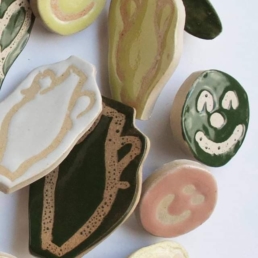
Advice and reflection
16. What advice would you give to someone starting out as a maker?
Go for it, try and spend as much time as possible on your work so you feel really happy and confident with your outcome
17. If you could go back to the start of your career, what advice would you give your younger self?
Say yes to opportunities, don’t worry (about the money side), believe in yourself and go for it !
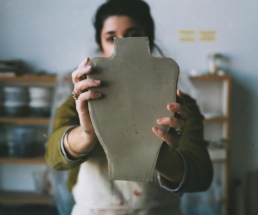
Closing thoughts
18. If you could collaborate with any artist, past or present, who would it be and why?
I think it would be really fun to collaborate on some kind of homeware with Ray Eames, I love her playful approach to design, colour, and materiality, especially her products aimed more so at children. Also just to have been able to hang out in their home and studio would have been a dream.
19. Where can people find your work, and how can they support you?
At the moment please message me through Instagram or email and I can send you my available stock list, but also if you are interested in orders and commissions, including my textile work
Lizzie Scarlett’s ceramics are rich with quiet stories, playful yet poetic pieces that honour both the past and the present. Balancing function with feeling, her work celebrates the handmade as a form of preservation: of knowledge, of joy, and of small, everyday rituals. With each unique object, Lizzie invites us to see domestic spaces as places of memory, creativity and care.
Explore Lizzie’s latest collection and follow her creative journey:
Support Lizzie by exploring her playful, memory-infused ceramics, discovering hand-built pieces that blend function with storytelling, and following her creative journey as she reimagines everyday objects through humour, history, and heart.


